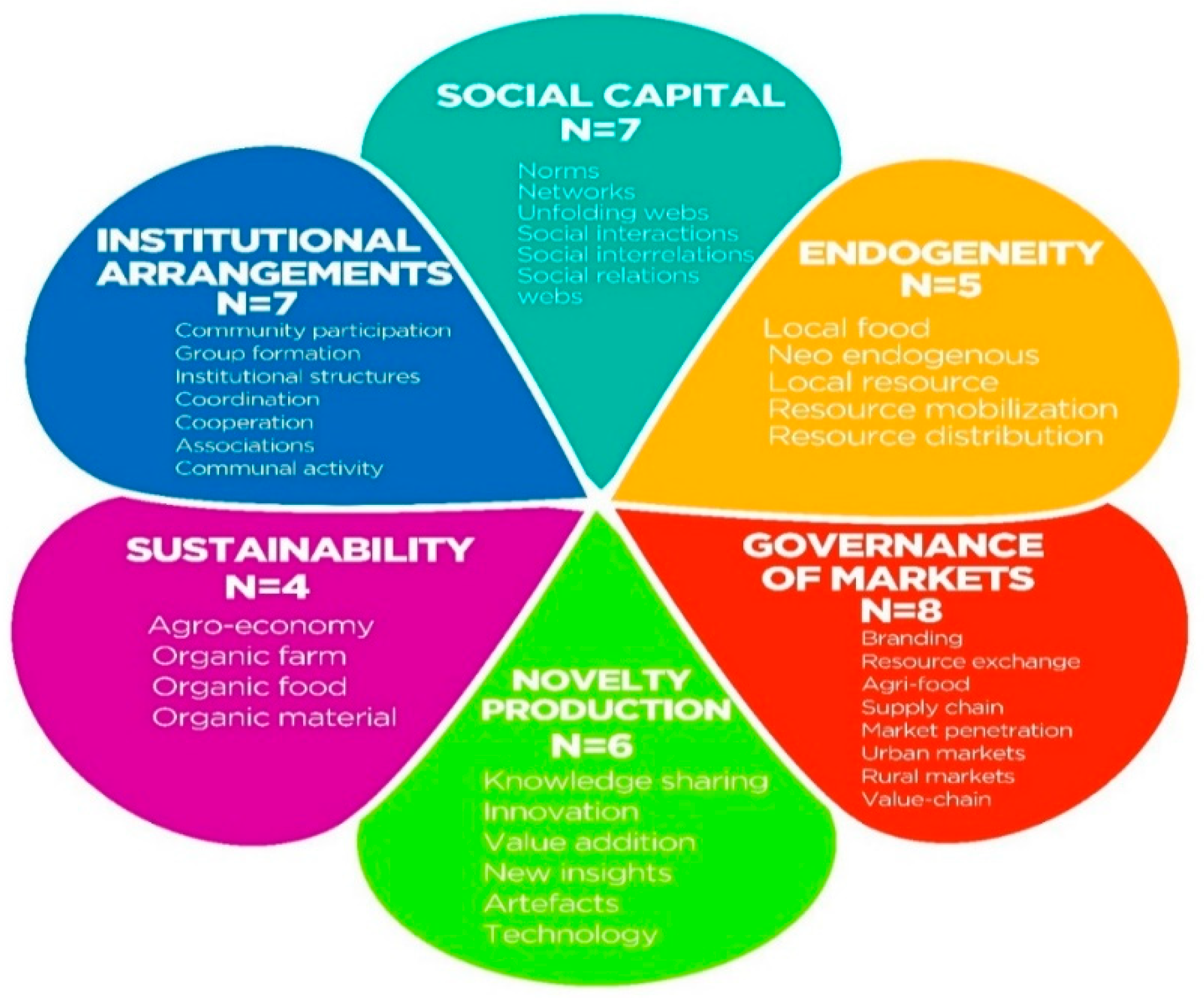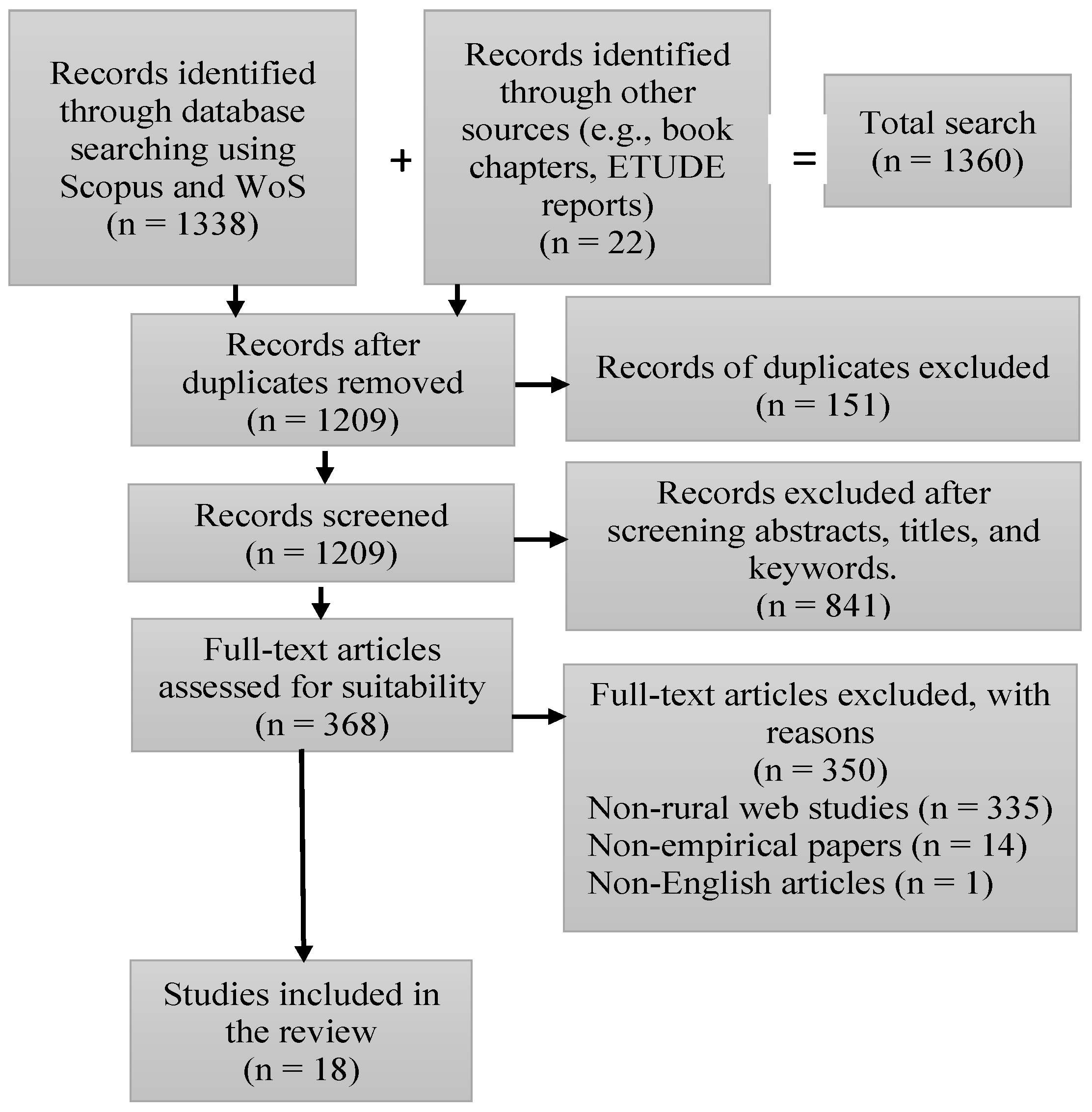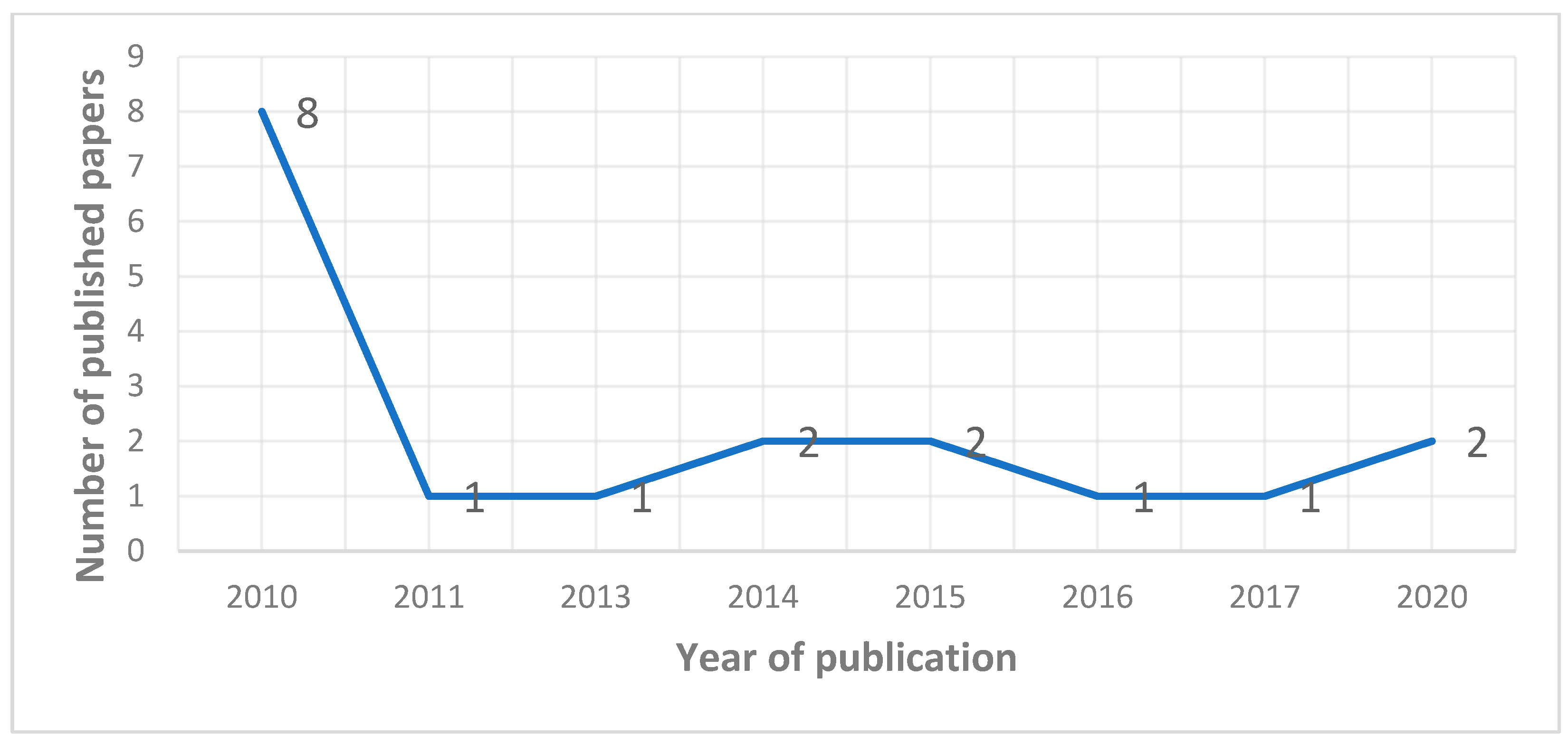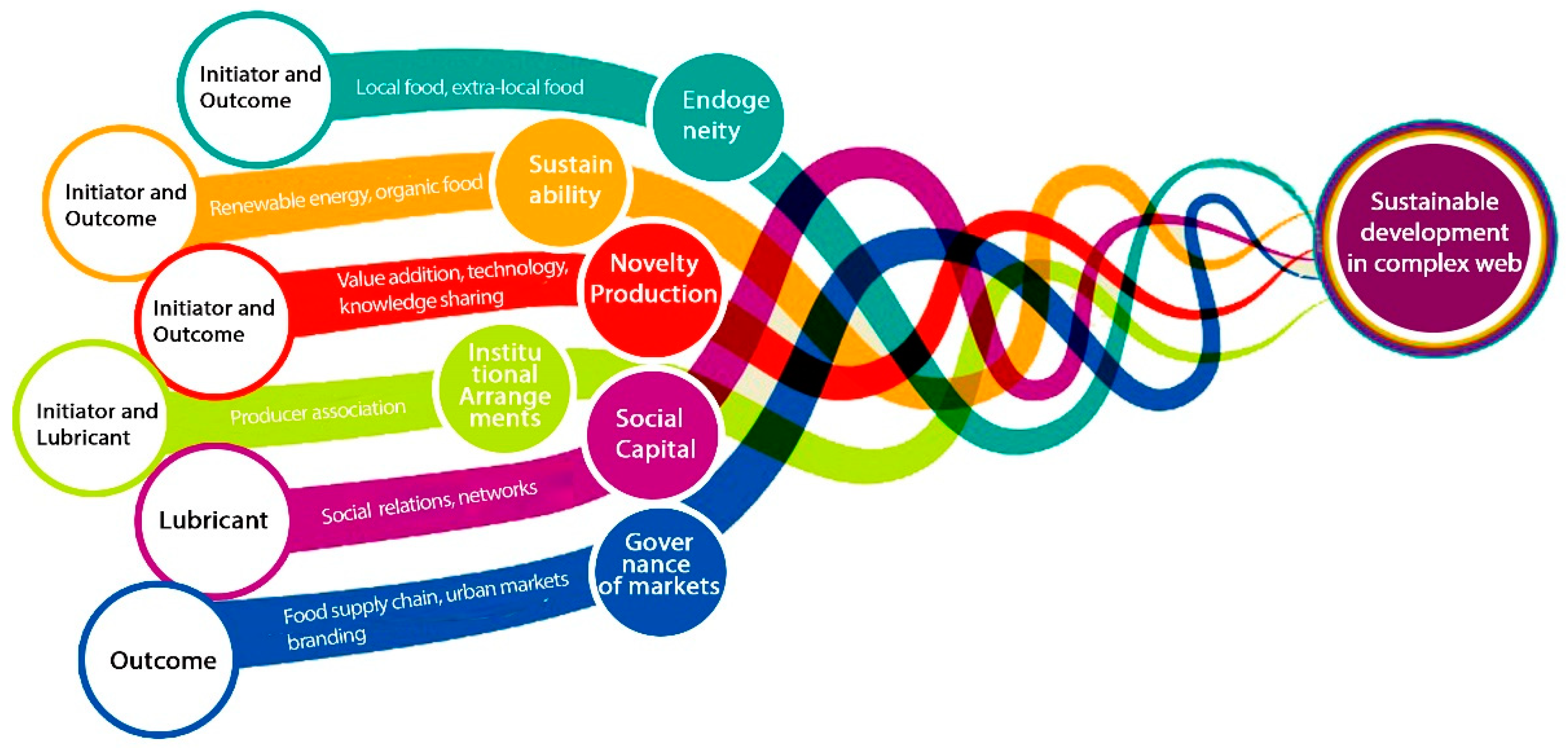Application of the Rural Web Framework within the Context of Sustainable Development: A Systematic Literature Review
Abstract
1. Introduction
2. Indicators of the Rural Web Framework
2.1. Endogeneity
2.2. Novelty Production
2.3. Social Capital
2.4. Governance of Markets
2.5. Institutional Arrangements
2.6. Sustainability
3. Rural Web Framework and Sustainable Rural Development
4. Methodology
4.1. Scope of the Review
4.2. Identification of Research Papers
4.3. Screening
4.4. Inclusion of Records
5. Findings
5.1. Ecological Economy and Sustainable Agri-Food Systems
5.2. Agricultural Landscapes and Diversification
5.3. Evaluation of Stakeholder and Institutional Roles
5.4. Innovations and Indigenous Knowledge
6. Implications
7. Conclusions
8. Limitations and Future Research
Supplementary Materials
Author Contributions
Funding
Data Availability Statement
Conflicts of Interest
References
- Pizzi, S.; Caputo, A.; Corvino, A.; Venturelli, A. Management Research and the UN Sustainable Development Goals (Sdgs): A Bibliometric Investigation and Systematic Review. J. Clean. Prod. 2020, 276, 2–15. [Google Scholar] [CrossRef]
- Basson, M.; van Rensburg, H.; Cuthill, M.; Erdiaw-Kwasie, M.O. Is regional Government-Governance Nexus Deliverikung on Social Sustainability Promises? Empirical Evidence from Moranbah in Australia. Local Gov. Stud. 2018, 44, 826–847. [Google Scholar] [CrossRef]
- Caiado, R.G.G.; de Freitas Dias, R.; Mattos, L.V.; Quelhas, O.L.G.; Leal Filho, W. Towards Sustainable Development Through the Perspective of Eco-Efficiency—A Systematic Literature Review. J. Clean. Prod. 2017, 165, 890–904. [Google Scholar] [CrossRef]
- Leal Filho, W.; Manolas, E.; Pace, P. The future We Want: Key Issues on Sustainable Development in Higher Education After Rio and the UN Decade of Education for Sustainable Development. Int. J. Sustain. High. Educ. 2015, 16, 112–129. [Google Scholar] [CrossRef]
- Ploeg, J.D.; Marsden, T. Unfolding Webs, The Dynamics of Regional Rural Development; Royal Van Gorcum: Assen, The Netherlands, 2008; pp. 1–244. [Google Scholar]
- Guinjoan, E.; Badia, A.; Tulla, A.F. The New Paradigm of Rural Development. Theoretical Considerations and Reconceptualisation Using the Rural Web. Bull. Assoc. Span. Geogr. 2016, 71, 495–500. [Google Scholar] [CrossRef]
- Rashid, M.F.; Sulaiman, N.K.; Misnan, S.H.; Samsudin, N.A.; Ngah, I. Application of Rural Web in analysing the Economic Performance of Rural Areas in Johor. IOP Conf. Ser. Earth Environ. Sci. 2020, 447, 1–7. [Google Scholar] [CrossRef]
- Haider, L.J.; Boonstra, W.J.; Peterson, G.D.; Schlüter, M. Traps and Sustainable Development in Rural Areas: A Review. World Dev. 2018, 101, 311–321. [Google Scholar] [CrossRef]
- Ventura, F.; Milone, P.; Taragnoloni, L. Rural Economic Transition in the Upper Tiber Valley: From Tobacco to Diversification. In Networking the Rural, The Future of Green Regions in Europe; Milone, P., Ventura, F., Eds.; Royal van Gorcum: Assen, The Netherlands, 2010; pp. 49–65. ISBN1 9023247272. ISBN2 9789023247272. [Google Scholar]
- Esparcia, J. Innovation and Networks in Rural Areas. An analysis from European innovation projects. J. Rural Stud. 2014, 34, 2–14. [Google Scholar] [CrossRef]
- McGuire, R.; Longo, A.; Sherry, E. Tackling Poverty and Social Inclusion Using a Smart Rural Development Initiative. J. Rural Stud. 2022, 89, 161–170. [Google Scholar] [CrossRef]
- Woods, M. Rural; Routledge: Oxon, NY, USA, 2011; pp. 1–352. ISBN 9780415442404. [Google Scholar]
- Bowler, I. Endogenous Agricultural Development in Western Europe. Mag. Econ. Soc. Geogr. 1999, 90, 260–271. [Google Scholar] [CrossRef]
- Reyers, B.; Michele–Lee, M.; Haider, J.L.; Schluter, M. The Contributions of Resilience to Reshaping Sustainable Development. Nat. Sustain. 2022, 5, 657–664. [Google Scholar] [CrossRef]
- Sgroi, F. Evaluating of the Sustaina Modern Agri-Food Systems. J. Agric. Food Res. 2022, 9, 2–8. [Google Scholar] [CrossRef]
- Messely, L.; Rogge, E.; Dessein, J. Using the Rural Web in Dialogue with Regional Stakeholders. J. Rural Stud. 2013, 32, 400–410. [Google Scholar] [CrossRef]
- Milone, P.; Ventura, F.; Berti, G.; Brunori, G. Some notes on the Identification of Rural Webs. In Networking the Rural, The Future of Green regions in Europe; Ploeg, J.D., Marsden, T., Eds.; Royal van Gorcum: Assen, The Netherlands, 2010; pp. 30–48. ISBN1 9023247272. ISBN2 9789023247272. [Google Scholar]
- Horlings, I.; Marsden, T. The New Rural Paradigm and Redefining the Rural Web. In Networking the Rural, The Future of Green regions in Europe; Milone, P., Ventura, F., Eds.; Royal van Gorcum: Assen, The Netherlands, 2010; pp. 2133–2241. ISBN1 9023247272. ISBN2 9789023247272. [Google Scholar]
- Arato, M.; Speelman, S.; Dessein, J.; Huylenbroeck, G. Assessment of Socio-Economic Configuration of Value Chains: A Proposed Analysis Framework to Facilitate Integration of Small Rural Producers with Global Agribusiness. Int. Food Agribus. Manag. Rev. 2017, 20, 25–43. [Google Scholar] [CrossRef]
- Ventura, F.; Milone, P.; Ploeg, J.D. Understanding rural development dynamics. In Networking the Rural, The Future of Green regions in Europe; Milone, P., Marsden, T., Eds.; Royal van Gorcum: Assen, The Netherlands, 2010; pp. 1–29. ISBN1 9023247272. ISBN2 9789023247272. [Google Scholar]
- Moher, M.; Liberati, A.; Tetzlaff, J.; Altman, D.G.; PRISMA Group. Preferred Reporting Items for Systematic Reviews and Meta-Analysis: The PRISMA statement. J. Clin. Epidemiol. 2009, 62, 1006–1012. [Google Scholar] [CrossRef]
- Fatima, T.; Elbanna, S. Corporate Social Responsibility (CSR) Implementation: A Review and a Research Agenda Towards an Integrative Framework. J. Bus. Ethics 2022, 2, 1–17. [Google Scholar] [CrossRef]
- Edwards, P.; Clarke, M.; DiGuiseppi, C.; Pratap, S.; Roberts, I.; Wentz, R. Identification of Randomized Controlled Trials in Systematic Reviews: Accuracy and Reliability of Screening Records. Stat. Med. 2002, 21, 1635–1640. [Google Scholar] [CrossRef]
- Kanemasu, Y.; Sonnino, R.; Marsden, T. Rural Development in Devon: Exploring the Dynamics of an Emerging Web. In Networking the Rural, The Future of Green regions in Europe; Ploeg, J.D., Marsden, T., Eds.; Royal van Gorcum: Assen, The Netherlands, 2010; pp. 108–127. ISBN1 9023247272. ISBN2 9789023247272. [Google Scholar]
- Marsden, T. Mobilising the regional Eco-Economy: Evolving Webs of Agri–Food and Rural Development in the UK, Cambridge. J. Reg. Econ. Soc. 2010, 3, 225–244. [Google Scholar] [CrossRef]
- Marsden, T.; Yu, L.; Flynn, A. Exploring Ecological Modernisation and Urban–Rural Eco-Developments in China: The Case of Anji country. Town Plan. Rev. 2011, 82, 195–224. [Google Scholar] [CrossRef]
- Horlings, L.G.; Marsden, T.K. Exploring the New Rural Paradigm in Europe: Eco–Economic Strategies as a Counterforce to the Global Competitiveness Agenda. Eur. Urban Reg. Stud. 2014, 21, 4–20. [Google Scholar] [CrossRef]
- Paddock, J.; Marsden, T. Revisiting Evolving Webs of Agri-Food and Rural Development in the UK: The Case of Devon and Shetland. Res. Rural Sociol. Dev. 2015, 22, 301–324. [Google Scholar] [CrossRef]
- Horlings, L.G.; Kanemasu, Y. Sustainable development And Policies in Rural Regions: Insights from the Shetland Islands. Land Use Policy 2015, 49, 310–321. [Google Scholar] [CrossRef]
- Vecchio, Y.; Abdul-Latif, I.; Adinolfi, F.; Rosa, M.D. Geographical Indication to Build Up Resilient Rural Economies: A Case Study from Ghana. Sustainability 2020, 12, 2052. [Google Scholar] [CrossRef]
- Broekhuizen, R.; Oostindie, H. National Landscape Laa-Holland: Rural Web Dynamics in a Metropolitan LandScape. In Networking the Rural, The Future of Green Regions in Europe; Ploeg, J.D., Marsden, T., Eds.; Royal van Gorcum: Assen, The Netherlands, 2010; pp. 93–107. ISBN1 9023247272. ISBN2 9789023247272. [Google Scholar]
- Munchhaussen, S.; Knickel, K. Rural Development Dynamics: A Comparison of Changes in Rural Wen Configurations in Six European Countries. In Networking the Rural, The Future of Green Regions in Europe; Ploeg, J.D., Marsden, T., Eds.; Royal van Gorcum: Assen, The Netherlands, 2010; pp. 167–190. ISBN1 9023247272. ISBN2 9789023247272. [Google Scholar]
- Kull, M.; Onkalo, P.; Vihinen, H. New Institutional Arrangements and Rural Development: Cooperation in the Municipality of Kittila. In Networking the Rural, The Future of Green Regions in Europe; Ploeg, J.D., Marsden, T., Eds.; Royal van Gorcum: Assen, The Netherlands, 2010; pp. 67–91. ISBN1 9023247272. ISBN2 9789023247272. [Google Scholar]
- Tisenkopfs, T.; Lace, I. Smiltene Municipality: The Construction of Social Capital. In Networking the Rural, The Future of Green regions in Europe; Ploeg, J.D., Marsden, T., Eds.; Royal van Gorcum: Assen, The Netherlands, 2010; pp. 129–147. ISBN1 9023247272. ISBN2 9789023247272. [Google Scholar]
- Stoffelen, A.; Vanneste, D. Institutional (dis)Integration and Regional Development Implications of Whisky Tourism in Speyside, Scotland. Scand. J. Hosp. Tour. 2016, 16, 42–60. [Google Scholar] [CrossRef]
- Munchhausen, S.; Peter, S.; Knickel, K. Realising Sustainable Development on the Basis of Local Networks of Knowledge. In Networking the Rural, The Future of Green Regions in Europe; Ploeg, J.D., Marsden, T., Eds.; Royal van Gorcum: Assen, The Netherlands, 2010; pp. 155–166. ISBN1 9023247272. ISBN2 9789023247272. [Google Scholar]
- Oteros-Rozas, E.; Ruiz-Almeida, A.; Aguado, M.; Rivera-Ferre, M.G. A Social-Ecological Analysis of the Global Agrifood System. Proc. Natl. Acad. Sci. USA 2019, 116, 25465–26471. [Google Scholar] [CrossRef] [PubMed]
- Schramski, J.R.; Woodson, C.B.; Brown, J.H. Energy Use and The Sustainability of Intensifying Food Production. Nat. Sustain. 2020, 3, 257–259. [Google Scholar] [CrossRef]
- Abdulai, I.A.; Abdul-Moomin, A.; Abdulai, M.; Bukari, S. Contributions of Village Savings and Loans Associations to Rural Livelihoods’ Development in the Upper West Region, Ghana. SN Soc. Sci. 2022, 2, 2–22. [Google Scholar] [CrossRef]
- Ksoll, C.; Lilleor, H.B.; Lonborg, J.H.; Rasmussen, O.D. Impact of Village Savings and Loan Associations: Evidence from a Cluster Randomised Trial. J. Dev. Econ. 2016, 120, 71–85. [Google Scholar] [CrossRef]
- Kini, J.; Pouw, N.; Gupta, J. Organic Vegetables Demand in Urban Area Using a Count Outcome Model: Case Study of Burkina Faso. Agric. Food Econ. 2020, 8, 2–16. [Google Scholar] [CrossRef]
- Chagomoka, T.; Drescher, A.; Glasser, R.; Marschner, B.; Schlesinger, J.; Abdul–Razak, A.; Karg, H.; Nyandoro, G. Urban and Peri-Urban Agriculture and Its Implication on Food And Nutrition Insecurity in Northern Ghana: A Socio-Spatial Analysis Along the Urban–Rural Continuum. Popul. Environ. 2018, 40, 47–66. [Google Scholar] [CrossRef]
- Morshedi, L.; Lashgarara, F.; Hosseini, S.J.F.; Najafabadi, M.O. The Role of Organic Farming for Improving Food Security from The Perspective of Fars Farmers. Sustainability 2017, 9, 2086. [Google Scholar] [CrossRef]
- Lannucci, G.; FMartellozzo, F.; Randelli, F. Sustainable Development of Rural Areas: A Dynamic Model in Between Tourism Exploitation and Landscape Decline. J. Evol. Econ. 2022, 32, 991–1016. [Google Scholar] [CrossRef]
- Marja, R.; Tscharntke, T.; Batary, P. Corrigendum to “Increasing Landscape Complexity Enhances Species Richness of Farmland Arthropods, Agri-Environment Schemes Also Abundance—A meta-analysis”. Agric. Ecosyst. Environ. 2022, 326, 107822. [Google Scholar] [CrossRef]
- Malley, Z.J.; Hart, A.; Buck, L.; Mwambene, P.L.; Katambara, Z.; Mngongo, M.; Chambi, C. Integrated Agricultural Landscape Management: Case study on Inclusive Innovation Processes, Monitoring And Evaluation in the Mbeya Region, Tanzania. Outlook Agric. 2017, 46, 146–153. [Google Scholar] [CrossRef]
- Bene, D.C.; Francaviglia, R.; Farina, R.; Alvaro-Fuentes, J.; Zornoza, R. Agricultural Diversification. Agriculture 2022, 12, 369. [Google Scholar] [CrossRef]
- Kurdys-Kujawska, A.; Strzelecka, A.; Zawadzka, D. The Impact of Crop Diversification on the Economic Efficiency of Small Farms in Poland. Agriculture 2021, 11, 250. [Google Scholar] [CrossRef]
- Lang, L.D.; Behl, A.; Dong, N.T.; Temouri, Y.; Thu, N.H. Effect of Social Capital on Agribusiness Diversification Intention in the Emerging Market. J. Intellect. Cap. 2022, 23, 56–84. [Google Scholar] [CrossRef]
- Dessein, J.; Krom, M.; Bock, B. Investigating the Limits of Multifunctional Agriculture as the Dominant Frame for Green Care in Agriculture in Flanders and the Netherlands. J. Rural Stud. 2013, 32, 50–59. [Google Scholar] [CrossRef]
- Kerselaers, E.; Rogge, E.; Dessein, J.; Lauwers, L.; Huylenbroeck, G. Prioritising Land to be Preserved for Agriculture: A Context–Specific Value Tree. Land Use Policy 2011, 28, 219–226. [Google Scholar] [CrossRef]
- Tambo, J.A.; Wunscher, T. Farmer–led Innovations and Rural Household Welfare: Evidence from Ghana. J. Rural Stud. 2017, 55, 263–274. [Google Scholar] [CrossRef]
- Kuzma, E.; Padilha, L.S.; Sehnem, S.; Julkovski, D.J.; Roman, D.J. The Relationship Between Innovation and Sustainability: A Meta-Analytic Study. J. Clean. Prod. 2020, 259, 120745. [Google Scholar] [CrossRef]
- King, B.; Fielke, S.; Bayne, K.; Klerkx, L.; Nettle, R. Navigating Shades of Social Capital and Trust to Leverage Opportunities for Rural Innovations. J. Rural Stud. 2019, 68, 123–134. [Google Scholar] [CrossRef]
- FAO; IFAD; UNICEF; WFP; WHO. The State of Food Security and Nutrition in the World. Transforming Food Systems to Deliver Affordable Healthy Diets for All. Rome: FAO. Available online: https://www.fao.org/publications/sofi/2020/en/ (accessed on 11 January 2023).
- Doemberg, A.; Annette, P.; Ingo, Z.; Dirk, W.; Ulrich, S. Sustainability Assessment of Short Food Supply Chains (SFSC): Developing and Testing a Rapid Assessment Tool in One African and three European City Regions. Agric. Hum. Values 2022, 39, 885–904. [Google Scholar] [CrossRef]
- Sabet, N.; Azharianfar, S. Urban-Rural Reciprocal Interaction Potential to Develop Weekly Markets and Regional Development in Iran. Habitat Int. 2017, 61, 31–44. [Google Scholar] [CrossRef]
- Shafieisabet, N.; Mirvahesi, N. Benefits of Rural-Urban Interactions for Sustainable Food Security in Iran. Hum. Geogr.-J. Stud. Res. Hum. Geogr. 2022, 16, 20–31. [Google Scholar] [CrossRef]
- Kitchen, L.; Marsden, T. Creating Sustainable Rural Development Through Stimulating the Eco-Economy: Beyond the Eco-Economy Paradox? Sociol. Rural. 2009, 49, 274–294. [Google Scholar] [CrossRef]
- United Nations. Resolution Adopted by the General Assembly on 25 September 2015. 70/1 Transforming Our World: The 2030 Agenda for Sustainable Development. Washington DC: United Nations General Assembly. Available online: https://www.un.org/en/development/desa/population/migration/generalassembly/docs/globalcompact/A_RES_70_1_E.pdf (accessed on 15 January 2023).
- Davies, J.; Blekking, J.; Hannah, C.; Zimmer, A.; Joshi, N.; Anderson, P.; Chilenga, A.; Evans, T. Governance of Traditional Markets and Rural-Urban Food Systems in sub-Saharan Africa. Habitat Int. 2022, 127, 102620. [Google Scholar] [CrossRef]
- Paudel, A.; Smith-Hall, C. Empirically derived Typologies of Environmental Product Periodic Markets and Retailers. Environ. Dev. Sustain. 2022, 24, 13111–13136. [Google Scholar] [CrossRef]
- Addai, G. Effects of Urban Periodic Markets on Rural Development in Ghana: A Rural Web Analysis. Ph.D. Thesis, University of Adelaide, Adelaide, Australia, 2021. [Google Scholar]
- Gyan, C.; Mfoafo-M’Carthy, M. Women’s Participation in Community Development in Rural Ghana: The Effects of Colonialism, Neoliberalism, and Patriarchy. Community Dev. 2021, 53, 296–308. [Google Scholar] [CrossRef]
- Newton, S.; Asbroek, G.T.; Hill, Z.; Agyemang, C.T.; Soremekun, S.; Etego, S.A.; Kirkwood, B. Maximising Community Participation and Engagement: Lessons Learned Over Two Decades of Field Trials in Rural Ghana. Emerg. Themes Epidemiol. 2021, 18, 2–7. [Google Scholar] [CrossRef] [PubMed]
- Addai, G.; Suh, J.; Bardsley, D. Contributions of Urban Periodic Markets to Sustainable Rural Development in Ghana: A Rural Web Analysis. Available online: https://ssrn.com/abstract=4234546 (accessed on 11 January 2023).




| Thematic Areas | Author(s) | Dimension Focus | Study Method | Design | Emphasis on External Interactions | Study Design | Study Area |
|---|---|---|---|---|---|---|---|
| Ecological economy and sustainable agri-food systems | [24] | Endogeneity | Interview | Case study | No | Qualitative | United Kingdom (UK) |
| [25] | All dimensions | Interview | Case study | No | Qualitative | UK | |
| [26] | All dimensions | Interview | Case study | No | Qualitative | China | |
| [27] | All dimensions | Interview | Case study | No | Qualitative | UK, Germany, The Netherlands, Italy, Latvia, and Finland | |
| [28] | All dimensions | Interview | Case study | No | Qualitative | UK | |
| [29] | Endogeneity and institutional arrangements | Interview | Case study | No | Qualitative | UK and Scotland | |
| [19] | All dimensions | Questionnaire and Interview | Case study and action research | No | Qualitative | Mexico | |
| [30] | All dimensions | Questionnaire and Interview | Case study and action research | No | Quantitative | Ghana | |
| [7] | All dimensions | Interview | Case study | No | Qualitative | Malaysia | |
| Agricultural landscapes and diversification | [9] | All dimensions | Interview | Case study | Yes | Qualitative | Central Italy |
| [31] | Endogeneity | Interview | Case study | No | Qualitative | Netherland | |
| [32] | All dimensions | Interview | Case study | No | Qualitative | UK, Germany, The Netherlands, Italy, Latvia, and Finland. | |
| Stakeholders and institutional roles | [33] | Institutional framework | Interview | Case study | Yes | Qualitative | Finland |
| [34] | Social capital | Interview | Case study | Yes | Qualitative | Latvia | |
| [16] | All dimensions | Interview | Action research | No | Qualitative | Belgium | |
| [35] | All dimensions | Interview | Case study | No | Qualitative | Scotland | |
| Innovations and indigenous knowledge | [10] | Novelty production | Questionnaire and Interview | Case study and action research | No | Qualitative | Bulgaria, France, Australia, Slovenia, Germany, Switzerland, Poland, Italy, and Spain |
| [36] | All dimensions | Interview | Case study | No | Qualitative | Germany |
Disclaimer/Publisher’s Note: The statements, opinions and data contained in all publications are solely those of the individual author(s) and contributor(s) and not of MDPI and/or the editor(s). MDPI and/or the editor(s) disclaim responsibility for any injury to people or property resulting from any ideas, methods, instructions or products referred to in the content. |
© 2023 by the authors. Licensee MDPI, Basel, Switzerland. This article is an open access article distributed under the terms and conditions of the Creative Commons Attribution (CC BY) license (https://creativecommons.org/licenses/by/4.0/).
Share and Cite
Addai, G.; Abunyewah, M.; Erdiaw-Kwasie, M.O.; Okyere, S.A.; Gyensare, M.A.; Guodaar, L. Application of the Rural Web Framework within the Context of Sustainable Development: A Systematic Literature Review. Sustainability 2023, 15, 4239. https://doi.org/10.3390/su15054239
Addai G, Abunyewah M, Erdiaw-Kwasie MO, Okyere SA, Gyensare MA, Guodaar L. Application of the Rural Web Framework within the Context of Sustainable Development: A Systematic Literature Review. Sustainability. 2023; 15(5):4239. https://doi.org/10.3390/su15054239
Chicago/Turabian StyleAddai, Godfred, Matthew Abunyewah, Michael Odei Erdiaw-Kwasie, Seth Asare Okyere, Michael Asiedu Gyensare, and Lawrence Guodaar. 2023. "Application of the Rural Web Framework within the Context of Sustainable Development: A Systematic Literature Review" Sustainability 15, no. 5: 4239. https://doi.org/10.3390/su15054239
APA StyleAddai, G., Abunyewah, M., Erdiaw-Kwasie, M. O., Okyere, S. A., Gyensare, M. A., & Guodaar, L. (2023). Application of the Rural Web Framework within the Context of Sustainable Development: A Systematic Literature Review. Sustainability, 15(5), 4239. https://doi.org/10.3390/su15054239





